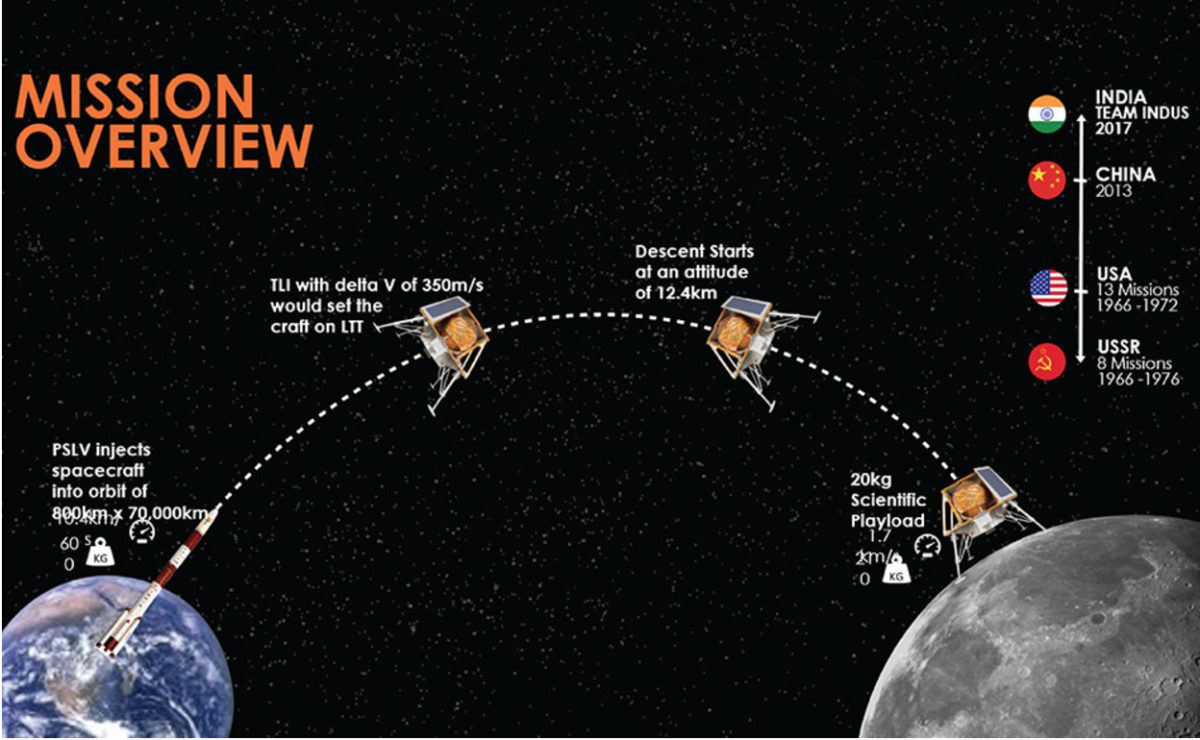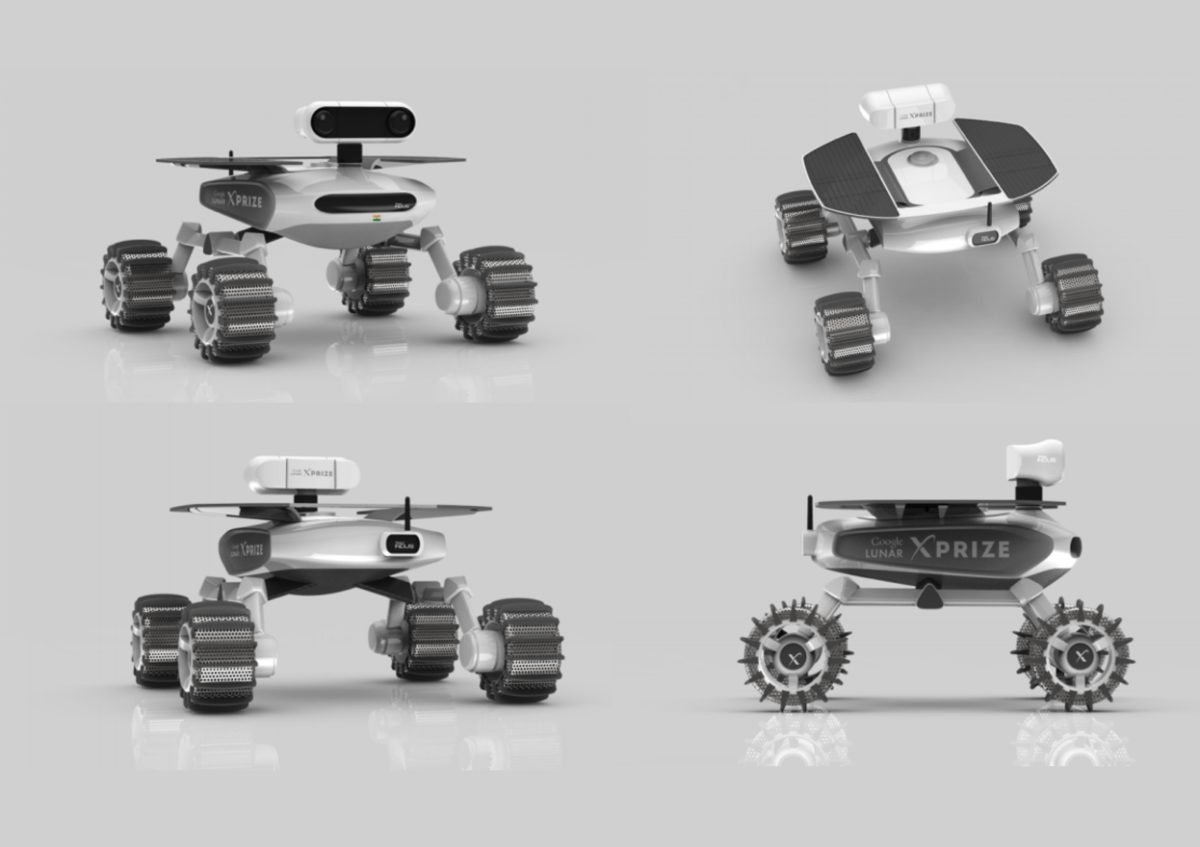Sandhya Ramesh • Dec 01, 2016
TeamIndus Announces Launch Contract with ISRO
TeamIndus, India’s only entry for the Google Lunar XPRIZE, just announced their launch contract with ISRO. If successful, TeamIndus would be the first private company from India to land a craft on an extraterrestrial body.
The Google Lunar XPRIZE (GLXP) is a competition for privately funded space companies to land a spacecraft on the Moon, deploy a rover to travel 500 meters on the surface and send back high-quality images and videos. The total prize money is $30 million, funded by Google. The winner would get $20 million, the runner up $5 million, and the other five is split across different milestone prizes through the course of the competition.
TeamIndus will launch their craft atop India’s trusty PSLV rocket. The final launch date hasn’t been announced yet, but the end of December 2017 seems to be the most likely window. The team previously announced the landing spot will be on Mare Imbrium, a sprawling lava plain. This large region was chosen to maintain a line-of-sight between the lander and the rover. Once the lander settles itself on the soft Moon dust there, it will deploy its rover. The lander will act as a communication relay to Earth.
The spacecraft will also carry the winning experiment from Lab2Moon, an ongoing competition TeamIndus announced earlier this year. The competition is open to student teams of up to three members under the age of 25 who submit experiments that help enable humans to become a multi-planetary species. The lander will also contain a small cube containing names of citizens who have contributed funding to the mission. Additionally, the team is also in talks with commercial entities to send marketing materials to the Moon.
In December 2014, TeamIndus was the recipient of one of the technical challenge prizes as a part of this competition. Titled the Landing Milestone Prize, a total of three teams were awarded $1 million for a demonstration of the capability of their landing hardware and software.
The Launch
For the launch from ISRO’s pad at Sriharikota, India, the PSLV rocket will carry the lander in its XL configuration. The payload, weighing 600 kilograms, will be injected into an 880-by-70,000 kilometer orbit, inclined at 19.2 degrees twelve minutes after launch. (70,000 km is the highest orbit provided by PSLV). The craft will then use two gravity assists around the earth, raising its apogee by 10,000 km the first time (G2; 80,000 km), and to 365,000 km the next (G3 to Lunar Transfer Trajectory), over a period of nine days to launch itself towards the Moon. At the Moon, the injection burn will let it enter an initial orbit of 100 by 6,700 kilometers (S1, as shown in the diagram). The orbit will then be lowered to 3,500 kilometers (S2), where the craft will be parked until sunrise over Mare Imbrium. There will then be another orbit-lowering maneuver bringing the apolune down to 100 kilometers. The craft will then go into a 100 kilometer circular orbit (S3). A final insertion burn will bring the perilune to 12.6 kilometers, from where descent onto the lunar surface would begin. This entire capture and descent sequence is expected to last a week, bringing the total time of the trip to 15 days.
Ground stations communicating with the spacecraft would be India’s ISRO Telemetry, Tracking, and Command Network (ISTRAC), Indian Deep Space Network (IDSN-Byalalu), and NASA’s Deep Space Network (DSN).
The lander and rover have a lifespan of one lunar day (14 Earth days) on the surface.
The Rover
The rover has undergone several design iterations over the past three years as shown below:
The rover is named ECA (pronounced eeka), which expands in Hindi to Ek Choti si Aasha, or “One Small Wish.” It weighs 7 kilograms with wheels made of high-strength aluminium. The rover’s body will be made of carbon fiber and aluminium, while the lander is comprised of aluminium and aluminium honeycomb sandwich composite panels. Both spacecraft will power themselves with solar panels, but will be perennially exposed to the sun.
ECA will move on the lunar surface at a speed of 6 centimeters per second, with a maximum speed of 10 centimeters per second. It will use an autonomous onboard navigation system, and come equipped with temperature and inertial sensors, a low-resolution camera for mapping terrain, and two high-resolution micro-cameras (called CASPEX or Colour cmos cAmera for SPace EXploration) for spotting obstacles in the rover’s path. The two state-of-the-art cameras are provided by CNES, the French national space agency. CNES has supplied cameras for other space missions in the past, including the Curiosity rover.
Out of the 13 teams still in the competition, four others have announced their launch contracts. SpaceIL is from Israel and has a contract with SpaceX (Given the recent unfortunate incident with the Falcon 9, SpaceIL’s launch could be delayed). Moon Express, a space startup owned by Silicon Valley entrepreneurs, have a contract with RocketLab. SynergyMoon, an international collaboration, has a launch contract with Interorbital Systems. The German team, PT Scientists, announced their launch contract with Spaceflight Industries two days ago, although this is yet to be verified by GLXP. The last date to announce a launch contract is Dec 31st of this year.
TeamIndus is owned by the parent company Axiom Research Labs, which was founded for the purpose of this mission by five former IT employees: Rahul Narayan, Indranil Chakraborty, Sameer Joshi, Dilip Chabria and Julius Amrit. The group also has advisors who have worked with ISRO. They are headquartered in Bangalore, India.
Let’s Go Beyond The Horizon
Every success in space exploration is the result of the community of space enthusiasts, like you, who believe it is important. You can help usher in the next great era of space exploration with your gift today.
Donate Today

 Explore Worlds
Explore Worlds Find Life
Find Life Defend Earth
Defend Earth






